scipy.special.kve#
- scipy.special.kve(v, z, out=None) = <ufunc 'kve'>#
Exponentially scaled modified Bessel function of the second kind.
Returns the exponentially scaled, modified Bessel function of the second kind (sometimes called the third kind) for real order v at complex z:
kve(v, z) = kv(v, z) * exp(z)
- Parameters:
- varray_like of float
Order of Bessel functions
- zarray_like of complex
Argument at which to evaluate the Bessel functions
- outndarray, optional
Optional output array for the function results
- Returns:
- scalar or ndarray
The exponentially scaled modified Bessel function of the second kind.
See also
Notes
Wrapper for AMOS [1] routine zbesk. For a discussion of the algorithm used, see [2] and the references therein.
References
[1]Donald E. Amos, “AMOS, A Portable Package for Bessel Functions of a Complex Argument and Nonnegative Order”, http://netlib.org/amos/
[2]Donald E. Amos, “Algorithm 644: A portable package for Bessel functions of a complex argument and nonnegative order”, ACM TOMS Vol. 12 Issue 3, Sept. 1986, p. 265
Examples
In the following example
kvreturns 0 whereaskvestill returns a useful finite number.>>> import numpy as np >>> from scipy.special import kv, kve >>> import matplotlib.pyplot as plt >>> kv(3, 1000.), kve(3, 1000.) (0.0, 0.03980696128440973)
Evaluate the function at one point for different orders by providing a list or NumPy array as argument for the v parameter:
>>> kve([0, 1, 1.5], 1.) array([1.14446308, 1.63615349, 2.50662827])
Evaluate the function at several points for order 0 by providing an array for z.
>>> points = np.array([1., 3., 10.]) >>> kve(0, points) array([1.14446308, 0.6977616 , 0.39163193])
Evaluate the function at several points for different orders by providing arrays for both v for z. Both arrays have to be broadcastable to the correct shape. To calculate the orders 0, 1 and 2 for a 1D array of points:
>>> kve([[0], [1], [2]], points) array([[1.14446308, 0.6977616 , 0.39163193], [1.63615349, 0.80656348, 0.41076657], [4.41677005, 1.23547058, 0.47378525]])
Plot the functions of order 0 to 3 from 0 to 5.
>>> fig, ax = plt.subplots() >>> x = np.linspace(0., 5., 1000) >>> for i in range(4): ... ax.plot(x, kve(i, x), label=fr'$K_{i!r}(z)\cdot e^z$') >>> ax.legend() >>> ax.set_xlabel(r"$z$") >>> ax.set_ylim(0, 4) >>> ax.set_xlim(0, 5) >>> plt.show()
